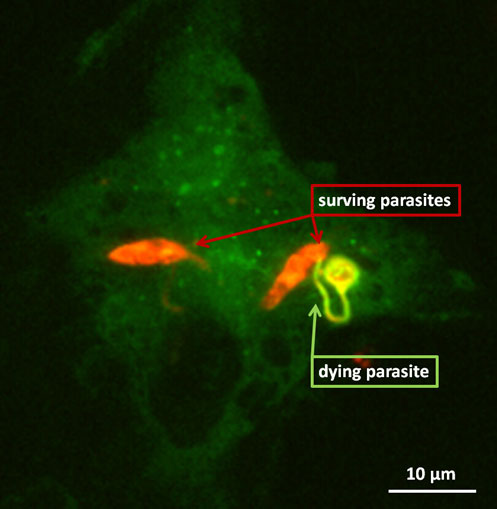Vitamin D and the Tropical Disease Leishmaniasis – New Findings on the Immune Defence of the Parasite

Leishmania infected human macrophage Source: Paul-Ehrlich-Institut
Leishmania are single-cell parasites transmitted by sandflies. They cause leishmaniasis, an infection that occurs above all in tropical areas, the Mediterranean, and Asia. However, sandflies are moving further and further north and, in the meantime, have also been found in Germany.
The type and degree of severity of leishmaniosis depends on the type of the parasite and the individual health status of the person affected. The infection can cause skin lesions, which, in healthy persons, normally heal.
The underlying mechanism of the human immune response contributing to this spontaneous healing process are so far not understood. Its elucidation will enable developing new treatments against this neglected disease.
So far, little is known about which processes take place during the defence of parasites by human macrophages. A group of researchers at the Paul-Ehrlich-Institut (PEI), Federal institute for Vaccines and Biomedicines, led by Prof. Dr. Ger van Zandbergen, head of Division Immunology, and Dr Peter Crauwels, in co-operation with researchers from Germany, Sweden, and Ethiopia have examined infected skin areas from Ethiopian patients.
In doing so, they found a variant of the human CAMP gene (increased mRNA expression). The CAMP gene encodes the so-called cathelicidin (LL37). Being a key molecule in immune defence, cathelicidin possesses antimicrobial properties effective against bacteria, viruses, fungi, and also parasites. Vitamin D indirectly stimulates the production of cathelicidin.
As the PEI research group found out, recombinant cathelicidin was able to induce cell death in leishmania, depending on its dose. The researchers were able to provide evidence that pro-inflammatory macrophages (hMDM1) formed cathelicidin to a greater extent through mechanisms of transcription and translation that occurred at the gene and protein level than did anti-inflammatory macrophages (hMDC22).
This increased cathelicidin production was caused by vitamin D by activation of the CAMP signal pathway, thus limiting the leihmania infection. On the other hand, more leishmania survived when cathelicidin was disabled in the hMDM1 macrophages.
The results of the studies on affected skin areas of infected patients and the in vitro findings described with human immune cells show that vitamin D mediated cathelicidin plays a significant role in the congenital immune response against the leishmanial parasite.
Vitamin D is formed in the skin during exposure to sun light, i.e. exposure of the skin areas affected to sun light may have a favourable effect on the healing process. This would have to be verified in further studies.
Crauwels P, Bank E, Walbers B, Wenzel UA, Agerberth B, Negatue MC, Alemayehu MA, König R, Ritter U, Reiling N, van Zandbergen G (2019): Cathelicidin mediated elimination of Leishmania in human host macrophages.
Front Immunol Nov 22 [Epub ahead of print].
DOI: https://doi.org/10.3389/fimmu.2019.02697
https://www.frontiersin.org/articles/10.3389/fimmu.2019.02697/full?&utm_sour… – Publication (Fulltext)
https://www.pei.de/EN/newsroom/press-releases/year/2019/23-vitamin-d-and-leishma… – This press release on the Website of the Paul-Ehrlich-Institut
Media Contact
All latest news from the category: Life Sciences and Chemistry
Articles and reports from the Life Sciences and chemistry area deal with applied and basic research into modern biology, chemistry and human medicine.
Valuable information can be found on a range of life sciences fields including bacteriology, biochemistry, bionics, bioinformatics, biophysics, biotechnology, genetics, geobotany, human biology, marine biology, microbiology, molecular biology, cellular biology, zoology, bioinorganic chemistry, microchemistry and environmental chemistry.
Newest articles

Future AR/VR controllers could be the palm of your hand
Carnegie Mellon University’s EgoTouch creates simple interfaces for virtual and augmented reality. The new generation of augmented and virtual reality controllers may not just fit in the palm of your…

‘Game changer’ in lithium extraction
Rice researchers develop novel electrochemical reactor. A team of Rice University researchers led by Lisa Biswal and Haotian Wang has developed an innovative electrochemical reactor to extract lithium from natural…

The blue-green sustainable proteins of seaweed
… may soon be on your plate. The protein in sea lettuce, a type of seaweed, is a promising complement to both meat and other current alternative protein sources. Seaweed…



